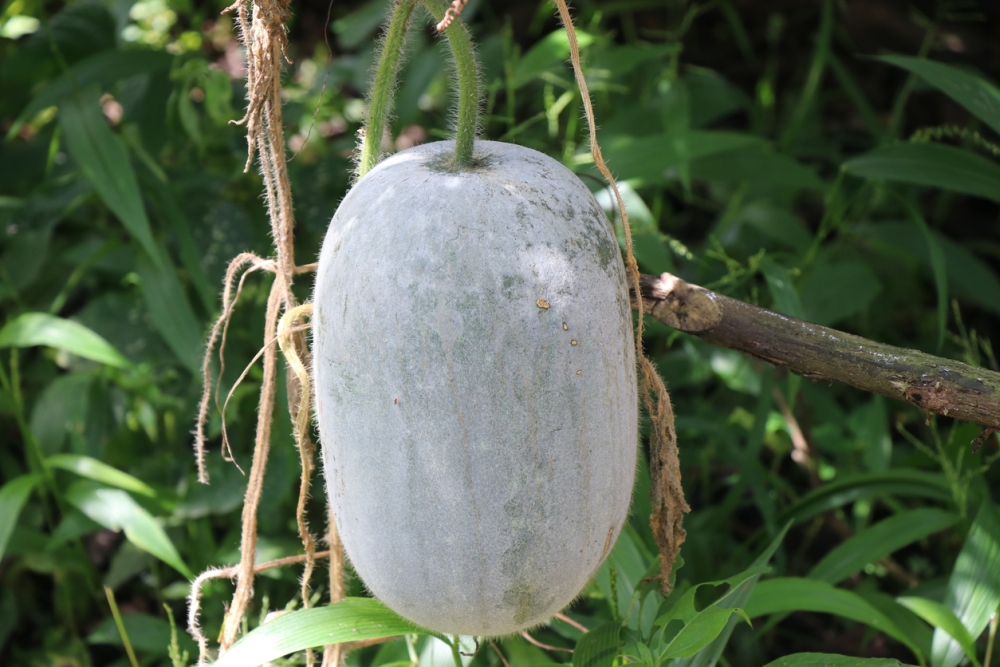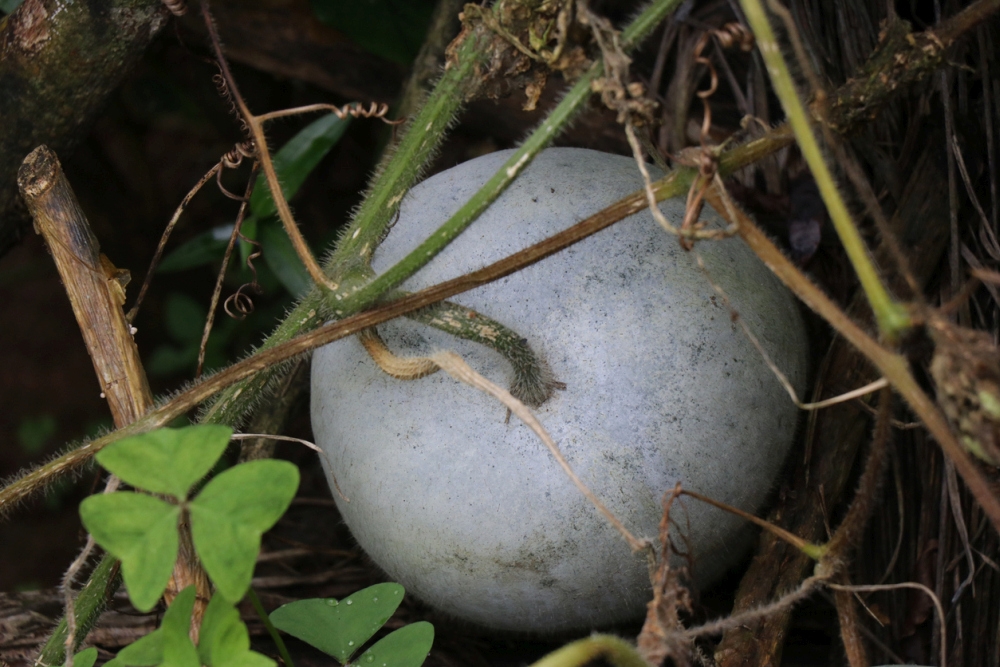Winter Melon Care – How To Grow And Harvest Wax Gourd
Winter melon sounds like an oxymoron. Melons are usually associated with the summer months and warm weather. So what’s the deal with winter melon?
Despite their name, these veggies are very much summer-loving plants. They need as much sun and as many frost-free days as any other melon variety. But that’s as far as the resemblance goes. Unlike melons, these veggies are not sweet and cannot be eaten raw. Once you’ve removed the skin and seeds, the white flesh can be cooked the same way you’d cook zucchini for example. You can steam it, braise, simmer it or even add it to stir fry dishes. When cooked, the crispy winter melon flesh becomes soft and acquires a mild taste. So herbs and spices are recommended when cooking this gourd. Read more to find out how to grow, care for, and harvest winter melon.
All about Winter Melon
A native of Asia, winter melon (Benincasa hispida) goes by many names. Depending on the culture it can be called wax gourd, winter gourd, ash gourd, white gourd, or ash pumpkin. As for the winter in the name, it’s because some varieties of the winter melon become ripe and ready to harvest in the late fall or early winter. And thanks to the waxy coat that protects its white flesh, the ripe fruits have a long shelf life and can be stored throughout the winter.
The melons grow on a vine that produces bright yellow flowers in the spring. After pollination, the small fruit develops at the bottom of the female flower. The oblong fruits grow to about one foot long and are usually covered with fine hairs. By the time it matures, it will weigh about 40 pounds on average and lose its hair.
Winter melon has been used for food and medicine all over Southeast Asia. The fruits have been associated with spiritual awakenings by yogis while the Chinese have used them as the main stuffing in their mooncakes. Their health benefits are still under study.
During the year of the pandemic, some people in the USA received unknown seeds in their mail. After a lot of analysis, the seeds were determined to be winter melon seeds. However, the reason behind sending them from China to random addresses in the USA remains a mystery.
Winter Melon Varieties
Not all winter melon varieties taste or even look the same. Some are waxy while others have a rough texture. Their uses and the dishes you can make out of the ripe winter melon vary depending on the vine you grow. So you’ll need to choose your variety carefully so that you won’t end up with the wrong wax gourd on your dinner table. Here are some common varieties to grow in your garden.
- Casaba: A common variety distinguished with its creamy flesh and wrinkled skin. The ripe fruit weighs around 5 pounds at most and has fewer flavors than other varieties. You can use this variety in stir-fries, soups, broths, and as a replacement for zucchini. It takes up to 120 days to ripen.
- Crenshaw: A cultivar that combines the sweetness and orange flesh of the cantaloupe with the smooth texture of the casaba. The average fruit weighs about 6 pounds. You can eat this one raw as you would with other fruits or you can add it to smoothies, desserts, and cakes. You can harvest it 100 days from the day you plant it.
- Persian: Similar to cantaloupe in taste and texture but with a more knitted green skin. When it ripes, the skin turns yellow. The average ripe fruit weighs about 8 pounds and you can use it as a replacement for cantaloupes.
- Charental: The flesh of this variety is quite firm and deep orange. It is sweet and juicy when ripe. The skin of the fruit is slightly netted and turns yellowish-green as it nears harvesting. It only needs about 78 days for the fruits to be fully ripe.
- Honeydew: The light green smooth skin turns creamy as a sign that the fruit is ripe and ready to harvest. The flesh can be either white, green, creamy, or orange and the ripe fruit weighs 3 pounds. It is ready to harvest within 110 days.
How to Grow Winter Melon
Now that we have dispelled the myth about wax gourd being a winter veggie, we need to remind you that this is very much a summer vine. To start it in your garden, you need to get the seeds from reliable sources and not through unsolicited mail. Here’s how to grow winter melon in easy steps.
- The best time to start the seeds is 2 weeks after the last frost. Winter melon needs about 110 frost-free days to grow successfully.
- To give yourself a headstart especially if you don’t have a long growing season, you can start the seeds indoors about 6 weeks before the last frost.
- Prepare the soil, breaking the top 7 inches and mixing in a generous portion of aged manure or organic compost. Leave the soil to rest in the sun for a few weeks before planting the seeds.
- Arrange the soil into little mounds about one foot in diameter and the same in height.
- Plant about six seeds in each mound.
- Plant the seed one inch deep into the soil and cover it with a thin layer.
- Water the soil to get it moist. Don’t let the soil go dry until the seeds germinate.
- Depending on the soil temperature, the seeds could take anything from 10 days to 3 weeks to germinate.
- When the seedlings have developed 3 true leaves, thin them out leaving about 3 seedlings per mound.
Winter Melon Care
You can also use inverted hills instead of mounds to grow winter melon vines. They allow the vines to run alongside the mounds and improve the drainage and aeration of the soil. Once you have the vines growing successfully, you’ll need to cater to the water, pruning, and watch out for pests and diseases.
Soil
Well-drained loamy soil is the operative word for the success of the winter melon. Since you’ll be growing it on mounds, then even dense clay soil will work. However, it’s recommended that you mix in plenty of organic materials to such soil to improve its tilth and structure. Also, check the soil pH while you’re arranging it into mounds and make sure it’s either slightly acidic or neutral. Any reading between 6.0 to 6.8 is good enough for the wax gourd.
Water
Winter melon vines prefer the soil to be constantly moist. It has a low tolerance for both dry and wet soil. So striking a balance between the two extremes will keep your vines healthy and disease-free. The water needs of the melons will grow once the fruits start to develop. The average fruit has about 95 percent water and all those juices come from the moisture in the soil. When watering the vines, avoid getting the leaves wet since that could trigger a fungal infection. Also, you need to factor in the rainfall and humidity levels in your zone. Don’t water the soil unless the top one inch is fully dry.
Fertilizer
As with all edible plants you grow in your garden, it’s always better to use organic compost over chemical fertilizers. Between aged manure, homemade fertilizers, and composts, your plants will have better flavors and a more natural taste. Since winter melon needs rich soil, you’ll need to mix plenty of organic materials into the soil prior to planting the seeds. This gives the vines a good start and keeps them nourished throughout their short life. If you notice the vines showing signs of malnutrition with a slower than usual growth rate or smallish leaves, you can side dress the mounds with another dose of aged manure. Keep applying the fertilizer once every three weeks until the fruits reach their full size.
Pruning
As you’ll notice, the vines will rapidly grow and cover the hills and mounds you created with their dense foliage. But you’re not growing this annual for its leaves. It’s the precious fruits you’re after. All these extra branches and leaves do nothing but draw more energy and resources from the plant. So to encourage the vine to focus more on the fruits rather than the foliage, you’ll need to trim those sprawling branches. Remove all the old leaves near the base that have started to turn yellow. Keep the branches from getting entangled and cut away any infected ones. You can cut back the plant by about one-third but not more. Over-pruning can impact the vine’s growth and yield.
Pests and Diseases
While you’re working hard to keep the winter melon growing, pests of different types see the vine as an open invitation to feast on its juicy sap. Most notable among those pests are aphids, beetles, leafhoppers, squash vine borers, slugs, spider mites, snails, and squash bugs. Don’t use pesticides since they could find their way into the soil and end up in the fruits you eat. Instead, pick the big insects such as beetles and snails by hand and drown them in a bucket full of a mixture of water and laundry detergent. As for the small insects, you can use neem oil or rubbing alcohol to kills them on the vines and leaves.
As for diseases, watch out for fungal and bacterial infections such as powdery and downy mildew, septoria leaf spot, angular leaf spot, root rot, Alternaria blight, and others. Most of these infections are caused by spores and bacteria carried by the pests we listed above. So getting rid of those bugs, will limit the chances of having disease breakouts among the vines.
Harvesting Winter Melon
How long your winter melon needs for the fruits to become ripe and ready to harvest depends on the variety you grow. The good news is, the ripe fruits have many telltale signs that make it easy for you to harvest them before wildlife beats you to the succulent melons.
Fruits that start hairy, lose their hair, while those with green skin, change that color and turn yellow or creamy as the fruits ripen. But the one common indicator of a ripe winter melon regardless of its variety is the leaves on the vine turning yellow. It’s a sure sign the vine has turned off the nutrients and moisture spigot since the fruits no longer need any more of them.
Pick up the ripe fruit with both hands and give the stem a good twist to snap it off the vine. You can store the ripe melons for many months at room temperature and feed on them throughout the winter.

